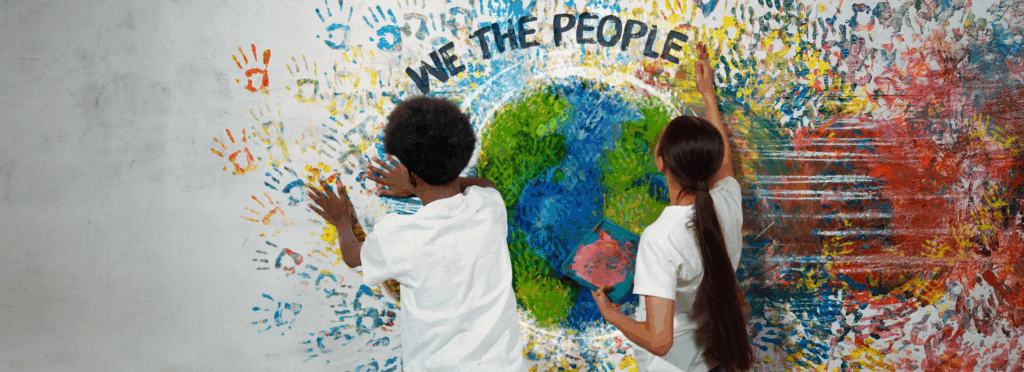Supporting Student Identity and Agency: Cultivating Civic Competency and Anti-Bias Awareness in Our Schools

How do we prepare students not only to succeed in college and career, but also to engage meaningfully and ethically in a diverse democracy? Civic competency and anti-bias awareness are not add-ons or special topics. They are essential to a well-rounded education and should be embedded in the fabric of every school. When students explore their own identities and develop awareness of bias and injustice, they gain the tools to participate more fully in their communities and to advocate for themselves and others.
OBJECTIVES
- Connect student voice to real-world civic issues
- Normalize respectful dialogue across differences
Two excellent resources from Learning for Justice provide a strong starting point for this work: Identity Artifacts Museum and Truth to Power: Writing Letters for Change. These student-centered activities help learners reflect on who they are, connect with diverse perspectives, and take meaningful, informed action. Both are designed with flexibility in mind, including strategies for engaging English language learners and multilingual students in authentic, empowering ways.
Centering Student Identity: The Identity Artifacts Museum
The Identity Artifacts Museum invites students to reflect on the different layers of their identity, such as family background, culture, interests, and values. It invites them to explore how these aspects come together and influence how they move through the world. By considering the intersectionality of their identities, students begin to understand that who they are is shaped by multiple, overlapping experiences.
Storytelling is a central part of this activity. Students curate creative representations of their identity and explain the meaning behind their choices. These might include writing, drawings, digital slides, or collages. Through this process, they practice sharing their perspectives and listening to the lived experiences of others.
The activity supports multiple forms of expression, which allows students to choose the format that best fits their voice and learning style. This flexibility also ensures that English language learners can participate fully through creative, visual, or multilingual approaches.
When students present their identity museums to peers or the broader school community, they see their experiences affirmed and learn to value the diverse stories that surround them. This fosters empathy, strengthens relationships, and contributes to a more inclusive school culture.
We all should know that diversity makes for a rich tapestry, and we must understand that all the threads of the tapestry are equal in value no matter what their color.
-Maya Angelou
Centering Student Voice: Truth to Power
Once students reflect on who they are, many are ready to explore what they care about. Truth to Power: Writing Letters for Change equips them to do exactly that. In this activity, students identify a social issue, research it, and write persuasive letters to decision-makers.
This project is rooted in real-world application. Students write for authentic audiences, develop evidence-based arguments, and learn how civic participation can drive change. It reinforces the idea that their voices are not just valid but vital.
Importantly, the lesson includes scaffolds and strategies for English language learners. Sentence starters, visual aids, translated instructions, and modeled writing help students express complex ideas in ways that match their language development. These supports make it possible for students learning English to fully participate in civic dialogue and build confidence in their ability to advocate for change.
In a time when many young people feel disconnected or disempowered, this kind of structured, purpose-driven writing can help them discover the impact they can have. As Learning for Justice puts it, students learn how to raise their voices against injustice in ways that make people listen,
Why This Matters for School Leaders
Civic learning and anti-bias education are essential for creating inclusive school communities where all students can thrive. When students have opportunities to explore identity, recognize injustice, and express their views on real-world issues, they develop critical thinking, empathy, and agency. These are skills that support both academic and personal growth.
This work does not require a complete shift in curriculum. It can be integrated into advisory periods, humanities classrooms, and cross-disciplinary projects. School leaders play a key role by creating the conditions for these practices to take root. That includes supporting staff collaboration, building flexibility into the schedule, and fostering a shared commitment to culturally responsive teaching.
Leading This Work in Your School
If schools are to be spaces where all students feel seen, heard, and supported, identity and civic learning must be part of the culture. The two tools from Learning for Justice are ready-to-use, culturally inclusive, and impactful.
Ask yourself: How is your school developing civic agency? How are you helping students explore identity and purpose?
When students understand who they are and believe their voices matter, they are more than ready. They are unstoppable.
Stay in the Loop
Subscribe to Our Newsletter






Responses